
When students come up with innovative solutions to real-world problems around them, educators can breathe easy, knowing that they have done something right! Nurturing scientific temper as an integral component of the school culture is key to achieving this goal.
Scientific temper, or scientific attitude is characterised by traits such as a healthy scepticism, universalism, freedom from prejudice or bias, objectivity, open mindedness and humility, willingness to suspend judgment without sufficient evidence, rationality, perseverance, and positive approach to failure. Normally, an individual with a scientific attitude, employs scientific methods in his/her daily life and decision making process, either consciously or unconsciously.
The spirit of enquiry is the principal element of scientific temper. When the pedagogical leaders build an environment and culture of fostering scientific temper in school, the school becomes a haven of curiosity and innovation. On the other hand, the absence of scientific temper weakens our ability to make rational decisions.
According to the recommendations of the NEP 2020, teachers should be sensitised to promote equitable classroom practices to ensure scientific experiences. So, what are the basic ingredients of scientific temper? How can it be assessed accurately? Which strategies are most appropriate to inculcate the spirit of science in the students?
Rational thinking can also be encouraged through traditional print media, folklore, folk dance, street plays, puppet shows etc. Electronic and digital media are widely being utilised today for effectively disseminating scientific information and knowledge. Blogs, e-newspaper, Wakelet and Padlet Walls, are some of the innovative communication channels through which scientific temper can be developed.
Teachers at Navrachana are aligned to these goals and standards and progress steadily towards the goal.

Quick tips for educators
- Creating a pro-science environment in school encourages children to make the most of their enquiring mind. Teachers at Navrachana encourage them to ask questions and allow them to seek out answers on their own. Our teachers guide and direct them to reliable sources of references in the library or the internet. They even suggest good programmes on the television for they feel that students can harness their TV time to be more beneficial when they watch scientific programmes rather than only for entertainment.
- Promote critical thinking skills to improve students’ problem-solving skills and IQ. Give them the liberty to doubt the well-established ideas. Let them use their reasoning and ask questions like, “Is there a way to prove this?” Provide them with the knowledge but allow them to marvel at mysteries that are yet to be solved.
- Support their experiments: Steer your students away from finding answers on the internet and encourage them to use their reasoning. Cheer them on when they create models or diagrams to explain their understanding. Motivate them to debate on the traditional and unfounded biases and arrive at their own conclusions.
- Teach them to study, and not learn: Avoid using chapter questions when it comes to academics. Pick up books once every few days and ask something that doesn’t have a direct answer in the book.
- Make learning application based: The rising of yeast, the metamorphosis of a caterpillar and the sprouting of saplings are some examples of application-based learning that they will enjoy. We live in times when there is a surfeit of knowledge in the form of reading material. Advise extra reading to improve their analysis of information.
- Employ Game-based Teaching: We can add the fun element to our students’ scientific thinking by playing games like chess that help in developing his logical sequencing and strategic skills. Reading comprehension passages not only improve their knowledge but also nurture their scientific temper. Make use of the riddles and brain teasers that are available on your to encourage their scientific exploration.
Navrachana School recently hosted the CBSE Regional Science Exhibition wherein the ethos of scientific temper was highlighted and exemplified. Both the participating teams of the school made it to the national round. The science team created a prototype of a Sowbot, a robot that can help the poor farmers of the country to sow seeds efficiently, without relying on expensive machinery. Another team that presented before CBSE chairperson Smt. Nidhi Chibber, created a Prosthetic Hand which can help amputees. The Math Team displayed their understanding of Mathematics with a static model called ‘Circling the Squares’ focused on the concept of optimisation of area to be covered using the various transformation of available shapes.
The NEP aims to chart out a path to liberate Indian science and ensure that the future generations of Indian scientists are rooted in Indian scientific thought. Therefore, schools need to put in efforts from the grassroots level.























